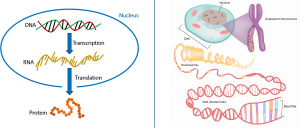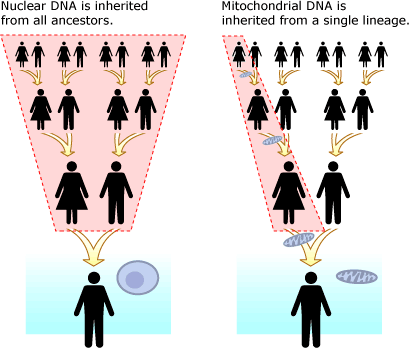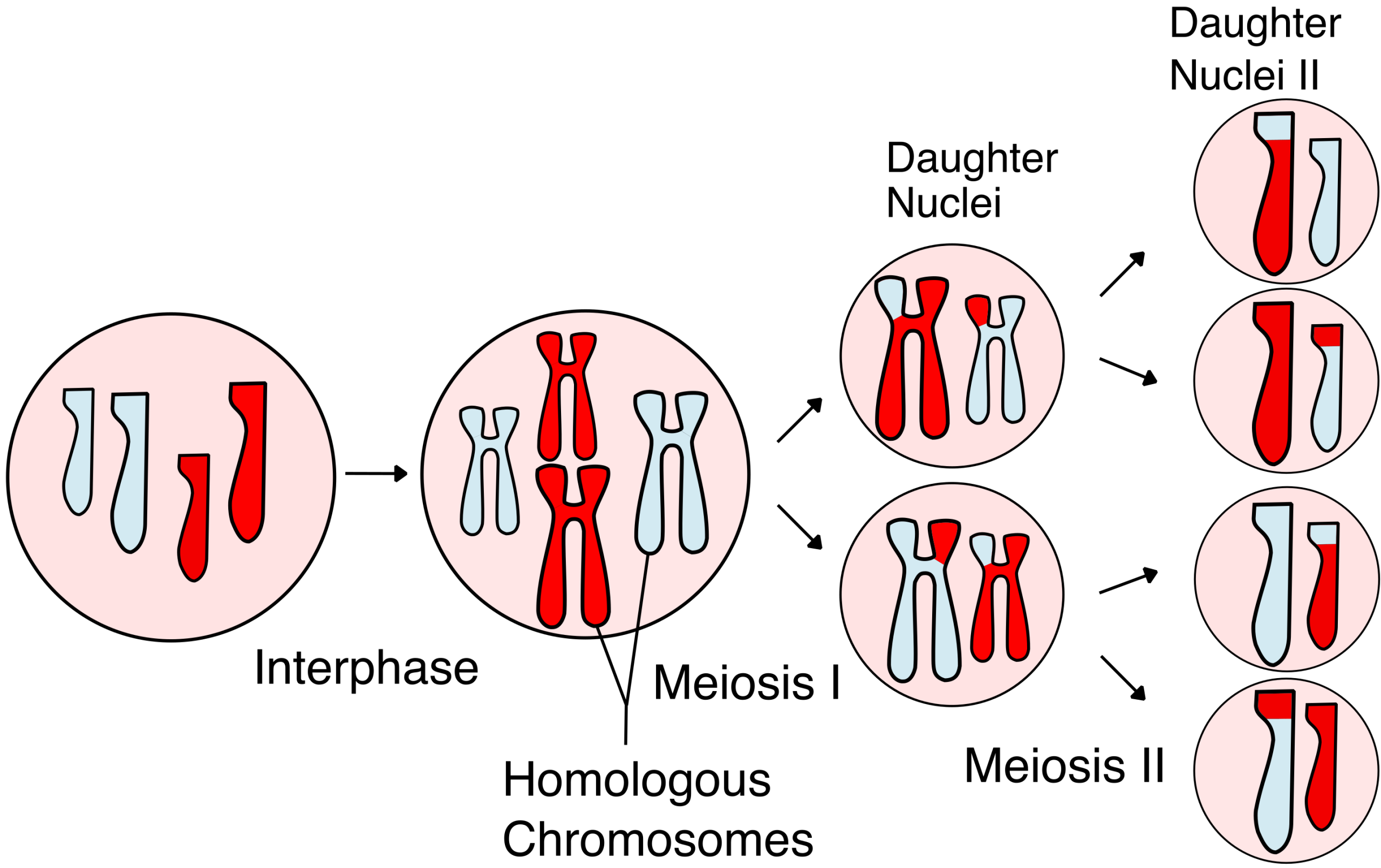Genetics is the study of how traits are inherited from one generation to the next. Traits are variations in physical characteristics determined by proteins, which in term are determined by genes—segments of DNA that direct protein production. In eukaryotes, chromosomes carry genes, and each cell typically contains two copies of each nuclear chromosome, one from each parent. Organelles like mitochondria and chloroplasts have they own DNA, which is typically inherited from the maternal parent only. During meiosis, gametes (eggs and sperm) are produced, each containing one copy of each chromosome. When fertilization occurs, the offspring receive two copies of each gene. These copies may differ and are known as alleles. The genetic makeup of an individual is called their genotype, which influences their observable traits, or phenotype.
15.2 Genes, Inheritance, and Meiosis
Elizabeth Dahlhoff
Learning Objectives
By the end of this section, you will be able to do the following:
- Describe the central importance of DNA as information molecule for genetics.
- Differentiate between genotype and phenotype.
- Explain the relationship between alleles, allelic variation, and homologous chromosomes.
- Explain the role of meiosis in genetic information flow.
Molecular Basis of Genetics and Evolution
Genetics is the study of how traits are inherited. A trait is defined as a variation in the physical appearance of a heritable characteristic. It seeks to understand how traits are passed from generation to generation. Before you start learning about the details of inheritance, let’s review some topics that are important in order to understand genetics. Recall that genes are segments of DNA that are typically several hundred or thousand bases long. Each gene directs the production of a protein through the process of protein synthesis: DNA gets transcribed to produce an mRNA; mRNA provides to code for a ribosome to produce a chain of amino acids.
Organisms get their traits from the proteins expressed in their bodies; proteins are produced using the information found in the organism’s DNA. Variation in the DNA between different organisms causes the production of proteins that contain differing orders of amino acids. These proteins can have different shapes and therefore different functions. When proteins function differently, this leads to differences in traits. In fact, you could say that proteins are ultimately the material upon which natural selection operates, while DNA is the blueprint of that action over time.


Meiosis
Meiosis is the process that produces eggs and sperm. Eggs and sperm are also known as gametes. During meiosis, one copy of each paired chromosome is moved into the gamete. Cells with one copy of each chromosome are known as “haploid“. This separation, or segregation, of the homologous (paired) chromosomes means also that only one of the copies of the gene gets moved into a gamete. The offspring are formed when that gamete unites with one from another parent and the two copies of each gene (and chromosome) are restored.
The offspring will receive two copies of each nuclear gene (one from each parent), but the copies are not necessarily identical. You already knew this – you don’t get identical information from your mother and your father because they have different DNA (which gives them different traits). The different versions of one specific gene are known as alleles. As you learn about genetics, you will learn about how the information from both alleles of a specific gene interact to give an individual their trait. The genetic information that an individual has is called their genotype. The genotype of an individual produces the individual’s phenotype, or physical traits.

Watch this great Amoeba Sisters video for a review of meiosis:
Glossary
- allele
- different versions of a gene that can exist at the same locus (position) on homologous chromosomes; alleles can lead to different traits or characteristics
- diploid
- a cell that contains two sets of chromosomes, one from each parent; most cells in organisms, including humans, are diploid
- fertilization
- the process in which a sperm cell and an egg cell join, combining their genetic material to form a zygote, which then develops into an offspring
- genotype
- the genetic makeup of an individual, consisting of the alleles inherited from both parents; it determines the potential traits an individual can exhibit
- haploid
- a cell that contains one complete set of chromosomes (half the number found in diploid cells); gametes (sperm and egg cells) are haploid
- homologous
- chromosomes that are similar in size, shape, and genetic content, one inherited from each parent; they carry the same genes, though they may have different versions (alleles)
- meiosis
- a type of cell division that reduces the chromosome number by half, producing gametes (sperm and egg cells); it ensures genetic diversity and allows for sexual reproduction
- phenotype
- the observable physical or biochemical characteristics of an individual, resulting from the interaction of their genotype and environmental factors
Figure Descriptions
Figure 15.2.1. Split image. Left panel: Diagram labeled “Nucleus” showing the central dogma of biology. At the top, a DNA double helix is labeled “DNA.” A downward arrow labeled “Transcription” points to a yellow strand labeled “RNA.” Another downward arrow labeled “Translation” points to a chain of orange circles labeled “Protein.” Right panel: Illustration of a eukaryotic cell with the nucleus magnified to show a purple chromosome. A zoomed-in section reveals coiled histone proteins, a twisted DNA double helix, and a colored base-pair sequence. [Return to Figure 15.2.1]
Figure 15.2.2. Two diagrams compare nuclear and mitochondrial DNA inheritance. Left panel: Labeled “Nuclear DNA is inherited from all ancestors,” showing people of different genders at the top, with arrows converging through multiple generations into a single person and a cell with a visible nucleus. Right panel: Labeled “Mitochondrial DNA is inherited from a single lineage,” showing only female ancestors passing mitochondrial DNA (depicted as blue mitochondria) through generations to one person, next to an enlarged mitochondrion. [Return to Figure 15.2.2]
Figure 15.2.3. A series of diagrams illustrates meiosis, starting with one cell containing two pairs of chromosomes (one pair red, one pair blue). Step 1 shows the chromosomes duplicated into X-shaped structures. Step 2 depicts the first cell division, with homologous chromosomes separating into two cells. Step 3 shows the second division, where sister chromatids separate, producing four cells, each with a single set of chromosomes. The red and blue coloring highlights genetic variation from mixing parental chromosomes. The diagram’s text explains that DNA is copied once, then the cell divides twice, producing sex cells with half the genetic material, which combine at fertilization to restore the full chromosome number. [Return to Figure 15.2.3]
Licenses and Attributions
Media Attributions
- Overview-of-the-central-dogma and deconstructed DNA
- 66390_evo_resources_resource_image_175_original
- Meiosis_Overview_new.svg
